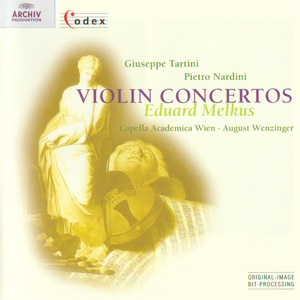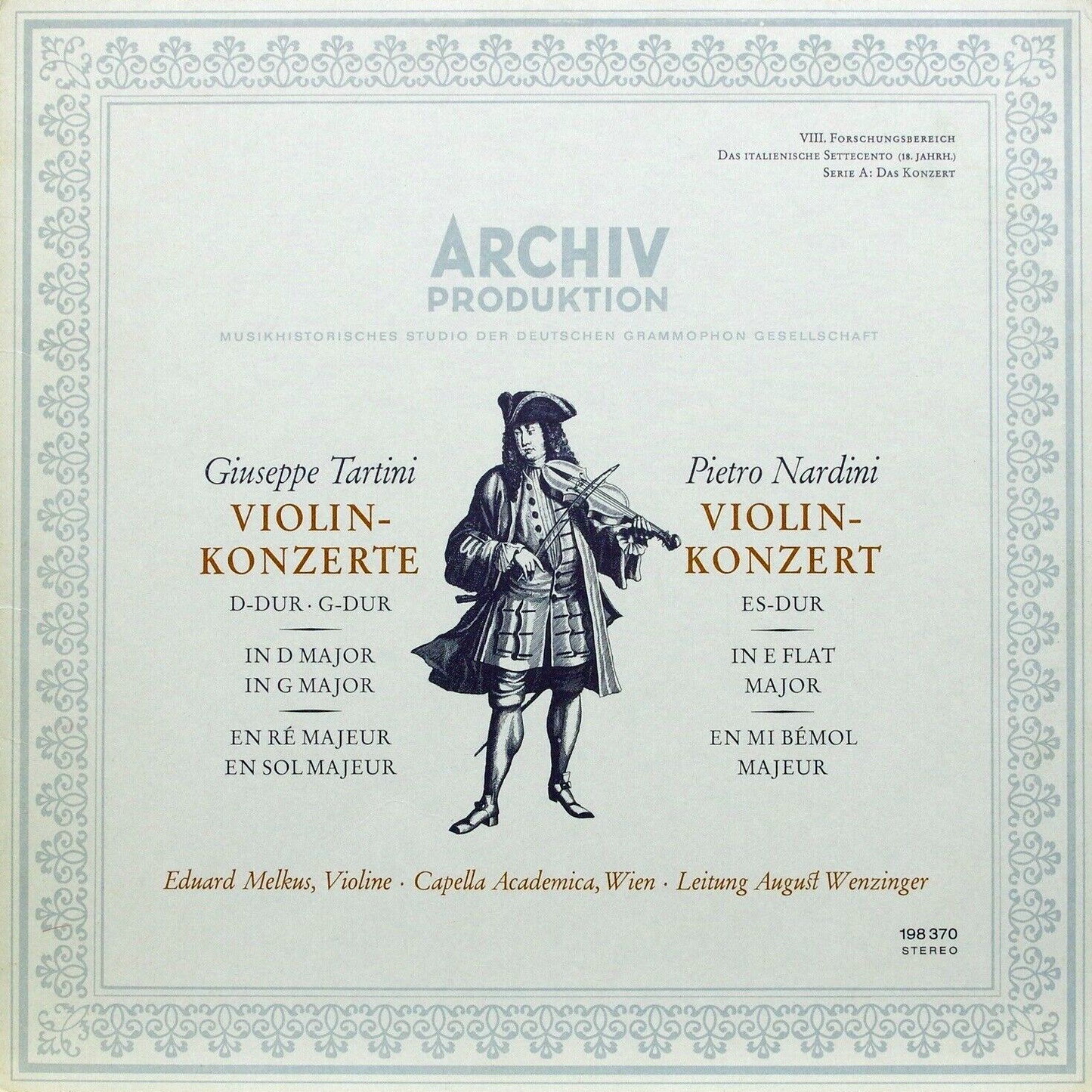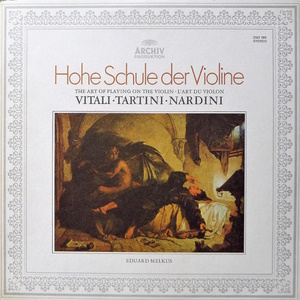 |
|
1 CD -
453 170-2 - (p) 1996
|
|
50
Jahre (1947-1997) - Codex I Serie - 9/10
|
|
|
|
|
|
|
|
VIOLIN CONCERTOS
|
|
|
|
|
|
|
|
Giuseppe
TARTINI (1692-1770)
|
Violin
Concerto in D major
|
|
13' 31" |
|
|
-
Allegro
|
4' 01" |
|
1 |
|
-
[Intermezzo]
|
0' 30" |
|
2 |
|
-
Andante cantabile |
5' 05" |
|
3 |
|
-
Allegro assai
|
3' 55" |
|
4 |
|
Violin
Concerto in G major |
|
16' 18" |
|
|
-
[Andante] |
6' 35" |
|
5 |
|
-
Largo andante - Grave |
4' 45" |
|
6 |
|
-
Presto |
4' 58" |
|
7 |
| Pietro NARDINI
(1772-1793) |
Violin
Sonata in D major *
|
|
15' 08" |
|
|
-
Adagio
|
6' 35" |
|
8 |
|
-
Allegro |
5' 41" |
|
9 |
|
-
Allegro
|
2' 52" |
|
10 |
|
Violin
Concerto in E flat major |
|
22' 27" |
|
|
-
Allegro |
9' 17" |
|
11 |
|
-
[Andante] |
5' 07" |
|
12 |
|
-
Allegro |
8' 03" |
|
13 |
|
|
|
|
Lionel Salter,
fortepiano *
Eduard Melkus, violin
CAPELLA ACADEMICA WIEN
August WENZINGER
|
|
|
|
|
|
Luogo
e data di registrazione |
|
Studio
Wien-Film, Rosenhügel, Wien
(Austria) - 11-14 febbraio 1966
(Concertos)
Palais Schönburg, Wien (Austria) -
26-29 gennaio 1971 (Sonata)
|
|
|
Original
Editions |
|
-
Archiv Produktion | 198 370 | 1 LP
| (p) 1967 | ANA | (Concertos)
- Archiv Produktion | 2533 086 | 1
LP | (p) 1972 | ANA | (Sonata)
|
|
|
Edizione
"Codex"
|
|
Archiv
Produktion "Codex" | 453 170-2 |
durata 67' 40" | LC 0113 | 1 CD |
(p) 1996 | ADD | stereo
|
|
|
Executive
Producer |
|
Prof.
Dr. Hans Hickmann (Concertos); Dr.
andreas Holschneider (Sonata)
|
|
|
Recording
Producer |
|
Dr.
Gerd Ploebsch
|
|
|
Tonmeister
(Balance Engineer) |
|
Harald
Baudis (Concertos); Hans-Peter
Schweigmann (Sonata)
|
|
|
Recording
Engineer
|
|
Hans-Rudolf
Müller (Sonata)
|
|
|
Cover |
|
Pierre
Subleyras: Fantaisie d'artiste,
les attributs des Arts (detail),
Musée des Augustins
|
|
|
Art Direction
|
|
Fred
Münzmaier
|
|
|
Note |
|
Original-Image-Bit-Processing
- Added presence and brilliance,
greater spatial definition |
|
|
|
|
|
ORIGINAL
EDITIONS

1 LP - 198 370 - (p) 1967
 1 LP - 2533 086 -
(p) 1972
1 LP - 2533 086 -
(p) 1972
|
Treasures
from Archiv Produktion’s
Catalogue
A rare and valuable collection of
documents is the pride of any
library or archive. CODEX, Archiv
Produktion’s new series, presents
rare documents in sound from 50
years of pioneering recording.
These recordings have been
digitally remastered using
original-image bit-processing
technology and can now be
appreciated in all the richness of
their original sound-image. They
range from the serene counterpoint
of a Machaut, the intensely
spiritual polyphony of a Victoria,
to the imposing state-music of a
Handel.
For the artists on Archiv
Produktion recordings, a constant
aim has been to rediscover the
musical pulse of past times and to
recreate the spirit of past ages.
In this sense each performance
here - whether by Pro Musica
Antiqua of Brussels in the 1950s,
the Regensburg Domchor in the
1960s, or Kenneth Gilbert and
Trevor Pinnock in the 1970s - made
a vital contribution to the
revival of Early Music in our
time.
CODEX highlights recordings that
were unique in their day, many of
them first recordings ever of this
rare and remarkable repertoire,
now appearing for the first time on
CD. A special aspect of the
history of performance in our
century can now be revisited, as
great moments from Archiv
Produktion’s recording history are
restored and experienced afresh.
Dr.
Peter Czornyi
Director,
Archiv Produktion
TARTINI - NARDINI: Violin
Concertos · Violin Sonata
Giuseppe Tartini, who was born at
Pirano in 1692 and died at Padua
in 1770, is of great interest not
only as one of the foremost
violinists of the 18th century,
but also as a composer, and as the
founder of a system of violin
playing which spread throughout
Europe, pointing forward to the
violin technique of modern times.
Another violinist Whose influence
was far-reaching was Tartini’s
pupil Pietro Nardini, who was born
at Livorno in 1722 and died at
Florence in 1793. He, together
with Locatelli, probably did most
to prepare the ground for the
virtuoso technique of Paganini,
and as a composer he was important
in connection with the evolution
of Viennese Classicism.
The violinist of today is strongly
attracted to early music. For one
thing the technical and tonal
challenge is fascinating, as
he/she attempts to revive the
ancient technique of playing a
short-necked violin with an
old-style bow, which has its own
interpretative characteristics,
for another thing, early music
pre-supposes improvisatory ability
in the performers, not only in the
realization of the accompaniment
from the figured bass, but to a far
greater degree in the fashioning
of the melodic line. There are
numerous theoretical examples
illustrating the art of
ornamentation as practised in
earlier times, but it is far less
common to discover complete works
with all the ornamentation
appertaining to them, and to be
able to apply them in performance.
The source material is often
scattered throughout the world,
and assembling it requires an
immense amount of patient labour.
The present recording is a living
example of this.
Both Tartini and Nardini were
praised especially by their
contemporaries for their inspired
playing of Adagios, by which is
meant principally not the use of
particular techniques of dynamics,
tone colouration or vibrato, but
the art of decorating the simple
melodies of slow movements and
giving them fresh nuances of
meaning. In the Works of both
composers there are written-out
examples of how this principle was
put into practice - the task was
to locate them.
The earliest work in this
recording is the Concerto in G
major, dating from the middle
period of Tartini’s creative
career. The library of the
Gesellschaft der Musikfreunde in
Vienna possesses a complete set of
manuscript orchestral parts of
this work, from which it may be
concluded that they were used at
the concerts given in Prague
during 1724 to mark the coronation
of the Emperor Charles VI. A
noteworthy fact is the careful
marking of parts for the
first-desk artists playing
together with the soloist, in
comparison with the rest of the
parts reserved for the musicians
who joined in only the tutti
passages. The solo part contains
an ornamented version of the slow
movement, so only the cadenzas
were needed for our recording, and
these were taken from Tartini’s Traité
des agréments.
Far more difficult was the task of
reconstructing the Concerto in D
major which, with its themes based
on broken triads, probably belongs
to Tartini‘s last period of
creative activity. Two authentic
scores are in existence: one in
the archives of the Capella S.
Antoniana in Padua, the other in
the library of the Paris
Conservatoire. This work, with its
use of wind instruments and
divided strings in the Padua
score, seems to occupy a special
place among Tartini’s many
concertos. The Paris manuscript,
however, contains only a
straightforward string
accompaniment in four parts.
Closer inspection led to the
surprising discovery that in the
Padua score, where the divided
string parts are always written in
the same staves, two different
versions of the accompaniment were
clearly written above one another:
the earlier handwriting gives the
text of the Paris score note for
note, while the later handwriting
provides a richer accompaniment
with the addition of wind
instruments. The harmonies in this
version are sometimes different,
so the two versions cannot have
been used simultaneously.
Evidently the later version with
fuller string accompaniment
together with wind instruments was
simply entered into the score
without the original version being
eliminated. The revision was
probably the work of Tartini’s
pupil and successor at the Capella
S. Antoniana, Meneghini, who is
known to have made arrangements of
other works by Tartini. There
appeared to be no ornamented
version of the slow movement in
existence until, thanks to a
valuable suggestion from Mr. Alan
Tyson and the kind assistance of
M. A. Rosenthal in Oxford, one was
obtained from Berkeley University,
California, where it forms part of
a collection of 18th-century
Italian manuscripts in the
University’s possession.
The Concerto in E flat major by
Nardini is accompanied by strings
and two horns, and the only set of
orchestral parts is the property
of the Gesellschaft der
Musikfreunde in Vienna. Nardini
was summoned to Vienna in 1765 for
the wedding festivities of the
Emperor Joseph II and possibly
played it there; the manuscript
parts remained in Vienna. It has,
however, been necessary to add
short fermatas, transitional
passages, and the capricci. The
latter, as Tartini wrote in his Traité
and as we can see from his own
works and especially from those of
Locatelli, were of considerable
length. (A wellknown example of
this kind of “capriccio” is the
extensive harpsichord cadenza in
Bach’s Fifth Brandenburg
Concerto.) Those recorded here are
from a collection of caprices in
the possession of the Gesellschaft
der Musikfreunde in Vienna, and
their style suggests that they
were probably composed by Nardini
himself. This recording
demonstrates not only the
evolution of the solo concerto of
the Padua school (Tartini and his
pupils), but also the richness of
the ancient art of ornamentation,
reproduced from authentic sources.
Nardini’s Sonata in D major was
first printed by Cartier in 1798
with reference to an older edition
from 1760. This particular sonata
appeared in Cartier’s collection
with six others “avec les Adagios
brodés”, that is to say with a
very frugal version of each
introductory adagio and a richly
embellished one printed above it.
These embellishments probably
represent the high point of this
development in the 18th century,
which often went beyond the limits
of good taste. Nardini, however,
does not try to outdo his tutor
Tartini in any conceivable way, as
can be seen from the embellished
slow movements he prepared. It is
the duty of a musician not to lose
sight of the poetical content and
musical cohesion of a piece of
music despite the rich scroll-work
it may have, and above all not to
make the embellishments a virtuoso
end in themselves, but to employ
them as an amplification
ofexpression. In the adagio we
have presented the simple version,
reserving the elaborated one for
the repetition. At the cadenza
fermata between the first and
second allegros we have inserted
stylistically authentic examples
from the collection of 246 Fantasie
e Cadenze by Bartolomeo
Campagnoli (1751-1827), a pupil of
Nardini’s.
In closing, a few remarks about
the instruments: The Capella
Academica plays valuable Italian
and German instruments belonging
to the Akademie für Musik in
Vienna. They correspond to
18th-century principles of
construction with their short
necks, thinner bass bars and
differently shaped bridges; these
instruments are played with bows
of corresponding design, which are
held in the Italian manner, above
the nut. The wind instruments,
too, are originals, the horns
belonging to the Haydn Orchestra
in Eisenstadt and kindly lent by
the Provincial Government of the
Burgenland; the oboe, which is the
property of H. G. Stradner, was
made by A. Grenser (1720-1807).
The violin, built by André Klotz
in 1760, has been maintained in
its original form, and with its
still short neck slightly set
back, the lengthened fingerboard
and narrow bass bar. It represents
the classical type of violin as we
know it from Mozart’s original
violin, which can be seen today in
the Mozarteum at Salzburg. This
type most probably also
corresponds to Tartini’s and
Nardini’s instruments, of which
one (although now altered) is kept
at Piran. The bow, which is
extremely light, is thin and bent
inwardly and has an elegant
swan-neck tip. It has its
counterpart in the bows used by
Tartini which still exist in the
Conservatorio “Giuseppe Tartini”
in Trieste. However, as important
as the instrument as such is the
manner in which it is handled, and
here we can see a particular
preference for the light manner of
holding the bow in the so-called
“Italian” style of the
18th-century, which is similar to
the present day’s with the
exception that the bow is held a
bit further up away from the frog.
Another preference is a
concentration of movement in the
flexibility of the wrist, as
opposed to more than a necessary
minimum of movement of the arm
itself.
We chose continuo instruments to
suit the violin: the cello from
Santo Seraphin (in contrast to the
violin, however, it had not
survived unaltered, but has only
been restored to its original
state), the positive organ with
its typical registration (8'
Gedackt, 4' Principal, 2' and 1'
stops) and the two-manual Kirckman
harpsichord. In the case of the
Nardini sonata we thought it
appropriate to use the “piano” of
the later 18th century, the
fortepiano, as an accompanying
instrument; it was just then
beginning to compete with the
harpsichord in this function. The
connection of Nardini’s
composition with Classicism is
thereby emphasized; at the same
time the difference between the
customary sound of today’s violin
and grand piano and the sonority
of the two historical instruments
is underlined.
The concert pitch adopted in
Vienna in former times seems to
have been higher than in other
musical centres - as it is today -
so that it almost corresponded to
our modern pitch. This fact is
proved by a number of wind
instruments of the period which
have come down to us with two
tuning pieces of different
lengths, the shorter of which
enables the instrument to play at
almost exactly present-day pitch.
The instruments of the Capella
Academica are therefore tuned to
a’ = 440.
Eduard
Melkus (1967/72)
(Translated
from the German)
|
|
|
|